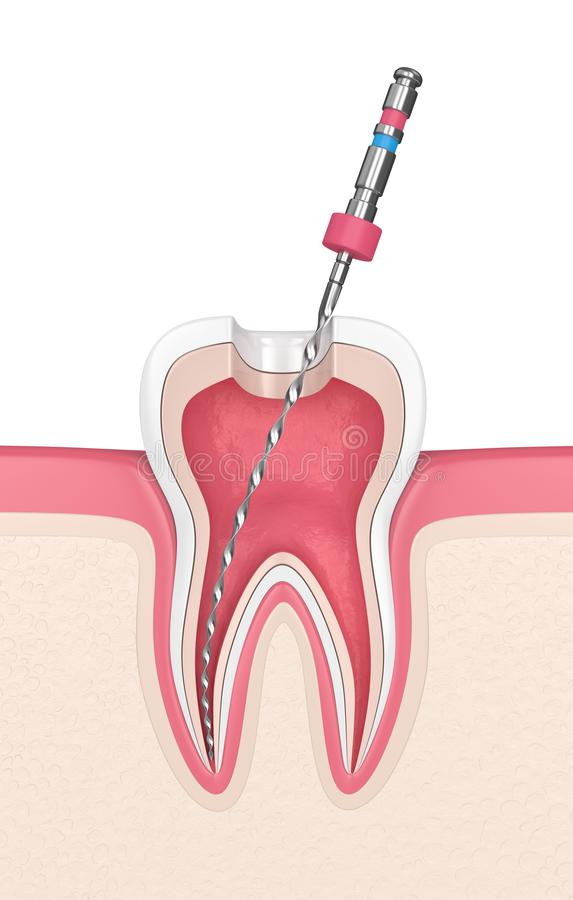Endodontric Treatment(Single Visit Root Canal)
What is root canal treatment?
A root canal is a natural cavity at the center of the tooth where the tooth’s nerve exists. Decay, infection or injury to the tooth affects the tooth nerves causing severe sensitivity, pain or swelling. Root canal treatment is the treatment of choice in order to save such teeth and prevent extraction.
Root canal treatment will remove the infected tooth nerves along with bacteria and toxins and seal the space. Without treatment, the infection will spread to the surrounding bone and gums and form pus.
What does a root canal infection feel like?
Signs and symptoms of root canal infection include;
1. Pain or sensitivity in the tooth to hot, cold and sweet foods
2. Pain on chewing or biting
3. Gum pain or swelling around the affected tooth
4. Pus around the roots of the tooth
5. Tooth discolouration
6. Unexplained pain radiating to the jaws, head, and neck
Sometimes there are no symptoms and a pulp vitality test might indicate an infected root canal
What does root canal treatment involve?
Depending on the case, it might take single or multiple visits to complete a root canal treatment. While the tooth is numb, a rubber dam (a sheet of rubber) will be placed around the tooth to isolate it (keep it dry and free of saliva). A cavity is made on top of the tooth to access the pulp and remove the contents of the root canal space.
Once the tooth is thoroughly cleaned, it is sealed with special root canal filling materials and a temporary or permanent filling is placed on top. If the infection is extensive then a root canal medicament is placed with a temporary seal on top till a permanent filling can be done.
After root canal treatment is completed, such teeth are further protected either with bonding, inlay, onlay or a crown. This added protection prevents the teeth from breaking and restores it to its full function.
What to expect after a root canal treatment?
Your tooth might be sensitive for a few days after the treatment. This is usually due to inflammation in the tissues around the root tip. But such pain or sensitivity can be easily controlled with proper medication and usually subsides as the inflammation diminishes. In rare cases, root canal therapy might not succeed due to improper healing or post-surgical complications.
There are a number of reasons why root canal treatment might unexpectedly fail:
1. Undetected or complex root canal structures
2. Saliva or blood entering the restoration
3. Improper sealing of the curved or narrow root canals
4. Delay in the placement of final restoration or crown following root canal therapy
5. Cracked crown
6. Leaking filling material
7. New fracture in the previously treated tooth
8. New decay in the previously treated tooth
However, root canal treatments and re-treatments are a better alternative than extraction in most cases. Root canal retreatment is not only economical. but also saves your natural tooth. An extensive bridgework or dental implants cost far more and require higher maintenance than a natural tooth.
What does root canal retreatment involve?
A root canal retreatment, depending on the case can be completed in one or multiple visits. While the tooth is numb, a rubber dam (a sheet of rubber) will be placed around the tooth to isolate it (keep it dry and free of saliva). Whether the treatment can be completed in a single visit will depend on the extent of infection and the complexity of treatment.
The first step in a root canal retreatment is to gain access to the inside of the tooth. If a crown and post have been placed, they will usually be removed. This is followed by the removal of the previous root canal filling. We might use loupes or microscopes for magnification during this process. The root canal space is then thoroughly cleaned and reshaped. If the root canals are complex then a medicament is packed inside the tooth and cleaning process is continued in the next appointment.
When we are confident that the infection has subsided and the root canal is completely clean, it is sealed with a root canal filling material like gutta-percha in combination with a sealer. This prevents bacterial invasion in the root canal space. Finally, such teeth are further protected either with bonding, inlay, onlay or a crown. This added protection prevents the teeth from breaking and restores it to its full function.
Your tooth might be sensitive for a few days after the treatment. This is usually due to inflammation in the tissues around the root tip. But such pain or sensitivity can be easily controlled with proper medication and usually subsides as the inflammation diminishes.
What is Endodontic Surgery and Microsurgery?
Endodontic microsurgery combines magnification and illumination provided by the dental loupes and surgical operating microscope. This procedure is performed using special microsurgery instruments. Without these microsurgical devices and instruments, procedures such as apicoectomy, internal and external resorption repair, as well as the repair of iatrogenic and pathological perforations would not be possible.
Unlike conventional endodontics, microsurgery is performed with great precision and predictability. The main advantage of microsurgery is a smaller surgical field which results in quicker healing with less post-operative discomfort.
At Dr Hada clinic, our doctors are specially trained in all areas of conventional and surgical endodontics. You can contact us to know more about the benefits of root canal treatment (endodontic treatment).
